Bibliometric Analysis on Smart Cities Research
Abstract
:1. Introduction
2. Data and Methods
3. Results and Discussion
3.1. Publication Output and Growth Trend
3.2. Co-Keyword and Keyword Citation Bursts Analysis
3.3. Co-Authorship Visualization Analyses
3.4. Countries/Regions Cooperation Analyses
3.5. Co-Operation of Organizations on Amart Xities
3.6. Journals Publishing on Smart Cities
4. Conclusions
Author Contributions
Funding
Acknowledgments
Conflicts of Interest
References
- Silva, B.N.; Khan, M.; Han, K. Towards sustainable smart cities: A review of trends, architectures, components, and open challenges in smart cities. Sustain. Cities Soc. 2018, 38, 697–713. [Google Scholar] [CrossRef]
- Jia, X.F.; Dai, T.; Guo, X.B. Comprehensive exploration of urban health by bibliometric analysis: 35 years and 11,299 articles. Scientometrics 2014, 99, 881–894. [Google Scholar] [CrossRef]
- Mohanty, S.P.; Choppali, U.; Kougianos, E. Everything you wanted to know about smart cities: The internet of things is the backbone. IEEE Consum. Electron. Mag. 2016, 5, 60–70. [Google Scholar] [CrossRef]
- Yigitcanlar, T.; Kamruzzaman, M.; Foth, M.; Sabatini-Marques, J.; Da Costa, E.; Ioppolo, G. Can cities become smart without being sustainable? A systematic review of the literature. Sustain. Cities Soc. 2019, 45, 348–365. [Google Scholar] [CrossRef]
- Bibri, S.E.; Krogstie, J. Smart sustainable cities of the future: An extensive interdisciplinary literature review. Sustain. Cities Soc. 2017, 31, 183–212. [Google Scholar] [CrossRef]
- Tan, Y.; Kamruzzaman, M.; Buys, L.; Ioppolo, G.; Sabatini-Marques, J.; Costa, E.M.D.; Yun, J.H.J. Understanding ‘smart cities’: Intertwining development drivers with desired outcomes in a multidimensional framework. Cities 2018, S0264275117313367. [Google Scholar]
- Neirotti, P.; Marco, A.D.; Cagliano, A.C.; Mangano, G.; Scorrano, F. Current trends in smart city initiatives: Some stylised facts. Cities 2014, 38, 25–36. [Google Scholar] [CrossRef]
- Darby, G.E. Can digital kiosks for travelers bring digital services to the local loop and make a city, or village, smart? A development strategy. In Proceedings of the Pacific Telecommunications Council Sixteenth Annual Conference Proceedings, Honolulu, HI, USA, 16–20 January 1994; pp. 230–233. [Google Scholar]
- Pelley, J. Building smart-growth communities. Environ. Sci. Tech. 1999, 33, 28A–32A. [Google Scholar] [CrossRef]
- Rosborough, D.; Cacy, K.; Amer Public Transit, A.; Amer Public Transit, A. Achieving Bus Route Efficiency through Smart Growth Land Use: Bus Transit’s Stake in Smart Growth Land Use; American Public Transit Assoc: Washington, DC, USA, 1998; pp. 214–218. [Google Scholar]
- Meer, A.V.D.; Winden, W.V. E-governance in cities: A comparison of urban information and communication technology policies. Reg. Stud. 2003, 37, 407–419. [Google Scholar] [CrossRef]
- Albino, V.; Berardi, U.; Dangelico, R.M. Smart cities: Definitions, dimensions, performance, and initiatives. J. Urban Technol. 2015, 22, 3–21. [Google Scholar] [CrossRef]
- Ismagilova, E.; Hughes, L.; Dwivedi, Y.K.; Raman, K.R. Smart cities: Advances in research—An information systems perspective. Int. J. Inf. Manag. 2019, 47, 88–100. [Google Scholar] [CrossRef]
- Rodrigues, S.P.; Van Eck, N.J.; Waltman, L.; Jansen, F.W. Mapping patient safety: A large-scale literature review using bibliometric visualisation techniques. BMJ Open 2014, 4, e004468. [Google Scholar] [CrossRef] [PubMed]
- Meijer, A.; Bolívar, M.P.R. Governing the smart city: A review of the literature on smart urban governance. Int. Rev. Adm. Sci. 2016, 82, 392–408. [Google Scholar] [CrossRef]
- Durand, C.P.; Andalib, M.; Dunton, G.F.; Wolch, J.; Pentz, M.A. A systematic review of built environment factors related to physical activity and obesity risk: Implications for smart growth urban planning. Obes. Rev. 2011, 12, e173–e182. [Google Scholar] [CrossRef] [PubMed]
- Sayegh, M.A.; Danielewicz, J.; Nannou, T.; Miniewicz, M.; Jadwiszczak, P.; Piekarska, K.; Jouhara, H. Trends of european research and development in district heating technologies. Renew. Sust. Energ. Rev. 2017, 68, 1183–1192. [Google Scholar] [CrossRef]
- Shi, W.; Cao, J.; Zhang, Q.; Li, Y.; Xu, L. Edge computing: Vision and challenges. IEEE Internet Things J. 2016, 3, 637–646. [Google Scholar] [CrossRef]
- Yang, C.; Huang, Q.; Li, Z.; Liu, K.; Hu, F. Big data and cloud computing: Innovation opportunities and challenges. Int. J. Digit. Earth 2017, 10, 13–53. [Google Scholar] [CrossRef]
- Diaz, M.; Martin, C.; Rubio, B. State-of-the-art, challenges, and open issues in the integration of internet of things and cloud computing. J. Netw. Comput. Appl. 2016, 67, 99–117. [Google Scholar] [CrossRef]
- Tzafestas, S.G. Ethics and law in the internet of things world. Smart Cities 2018, 1, 98–120. [Google Scholar] [CrossRef]
- Ugolini, D.; Bonassi, S.; Cristaudo, A.; Leoncini, G.; Ratto, G.B.; Neri, M. Temporal trend, geographic distribution, and publication quality in asbestos research. Environ. Sci. Pollut. Res. 2015, 22, 6957–6967. [Google Scholar] [CrossRef]
- Van Nunen, K.; Li, J.; Reniers, G.; Ponnet, K. Bibliometric analysis of safety culture research. Saf. Sci. 2018, 108, 248–258. [Google Scholar] [CrossRef]
- Li, W.; Zhao, Y. Bibliometric analysis of global environmental assessment research in a 20-year period. Environ. Impact Assess. Rev. 2015, 50, 158–166. [Google Scholar] [CrossRef]
- Van Eck, N.J.; Waltman, L. Software survey: Vosviewer, a computer program for bibliometric mapping. Scientometrics 2010, 84, 523–538. [Google Scholar] [CrossRef] [PubMed]
- Lulewicz-Sas, A. Corporate social responsibility in the light of management science—Bibliometric analysis. Procedia Eng. 2017, 182, 412–417. [Google Scholar] [CrossRef]
- Gall, M.; Nguyen, K.H.; Cutter, S.L. Integrated research on disaster risk: Is it really integrated? Int. J. Disaster Risk Reduct. 2015, 12, 255–267. [Google Scholar] [CrossRef]
- Wang, X.; Fang, Z.; Sun, X. Usage patterns of scholarly articles on web of science: A study on web of science usage count. Scientometrics 2016, 109, 917–926. [Google Scholar] [CrossRef]
- Postranecky, M.; Svítek, M. Dynamic social evolution model in virtual city laboratory. In Proceedings of the 2016 Smart Cities Symposium Prague (SCSP), Prague, Czech Republic, 26–27 May 2016; pp. 1–4. [Google Scholar]
- Baig, Z.A.; Szewczyk, P.; Valli, C.; Rabadia, P.; Hannay, P.; Chernyshev, M.; Johnstone, M.; Kerai, P.; Ibrahim, A.; Sansurooah, K.; et al. Future challenges for smart cities: Cyber-security and digital forensics. Digit. Investig. 2017, 22, 3–13. [Google Scholar] [CrossRef]
- March, H. The smart city and other ict-led techno-imaginaries: Any room for dialogue with degrowth? J. Clean. Prod. 2018, 197, 1694–1703. [Google Scholar] [CrossRef]
- De Jong, M.; Joss, S.; Schraven, D.; Zhan, C.; Weijnen, M. Sustainable–smart–resilient–low carbon–eco–knowledge cities; making sense of a multitude of concepts promoting sustainable urbanization. J. Clean. Prod. 2015, 109, 25–38. [Google Scholar] [CrossRef]
- Mora, L.; Bolici, R.; Deakin, M. The first two decades of smart-city research: A bibliometric analysis. J. Urban Technol. 2017, 24, 3–27. [Google Scholar] [CrossRef]
- Chen, C. Citespace ii: Detecting and visualizing emerging trends and transient patterns in scientific literature. J. Assoc. Inf. Sci. Technol. 2014, 57, 359–377. [Google Scholar] [CrossRef]
- Sun, C.; Ritchie, S.G.; Tsai, K. Algorithm development for derivation of section-related measures of traffic system performance using inductive loop detectors. In Pavement Management and Monitoring of Traffic and Pavements; National Academy of Sciences: Washington, DC, USA, 1998; pp. 171–180. [Google Scholar]
- Barrett, P.; Rose, M.H. Street smarts—The politics of transportation statistics in the american city, 1900–1990. J. Urban Hist. 1999, 25, 405–433. [Google Scholar] [CrossRef]
- Shehata, E.; Rizkalla, S. Intelligent sensing for innovative bridges. J. Intell. Mater. Syst. Struct. 1999, 10, 304–313. [Google Scholar] [CrossRef]
- Dameri, R.P.; Cocchia, A. Smart city and digital city: Twenty years of terminology evolution. In Proceedings of the X Conference of the Italian Chapter of AIS, ITAIS, Milan, Italy, 14 December 2013; pp. 1–8. [Google Scholar]
- Jucevičius, R.; Patašienė, I.; Patašius, M. Digital dimension of smart city: Critical analysis. Procedia Soc. Behav. Sci. 2014, 156, 146–150. [Google Scholar] [CrossRef]
- Torrie, G.M.; Valleau, J.P. Nonphysical sampling distributions in monte carlo free-energy estimation: Umbrella sampling. J. Comput. Phys. (USA) 1977, 23, 187–199. [Google Scholar] [CrossRef]
- Xiang, C.; Wang, Y.; Liu, H. A scientometrics review on nonpoint source pollution research. Ecol. Eng. 2017, 99, 400–408. [Google Scholar] [CrossRef]
- Sevinc, A. Web of science: A unique method of cited reference searching. J. Natl. Med. Assoc. 2004, 96, 980–983. [Google Scholar] [PubMed]
- Allam, Z.; Newman, P. Redefining the smart city: Culture, metabolism and governance. Smart Cities 2018, 1, 4–25. [Google Scholar] [CrossRef]
- Zhou, W.; Kou, A.Q.; Chen, J.; Ding, B.Q. A retrospective analysis with bibliometric of energy security in 2000–2017. Energy Rep. 2018, 4, 724–732. [Google Scholar] [CrossRef]
- Huang, L.; Kelly, S.; Lv, K.J.; Giurco, D. A systematic review of empirical methods for modelling sectoral carbon emissions in china. J. Clean. Prod. 2019, 215, 1382–1401. [Google Scholar] [CrossRef]
- Xu, H.; Geng, X. People-centric service intelligence for smart cities. Smart Cities 2019, 2, 135–152. [Google Scholar] [CrossRef]
- Chiu, W.T.; Ho, Y.S. Bibliometric analysis of tsunami research. Scientometrics 2007, 73, 3–17. [Google Scholar] [CrossRef]
- Riva Sanseverino, E.; Riva Sanseverino, R.; Anello, E. A cross-reading approach to smart city: A european perspective of chinese smart cities. Smart Cities 2018, 1, 26–52. [Google Scholar] [CrossRef]

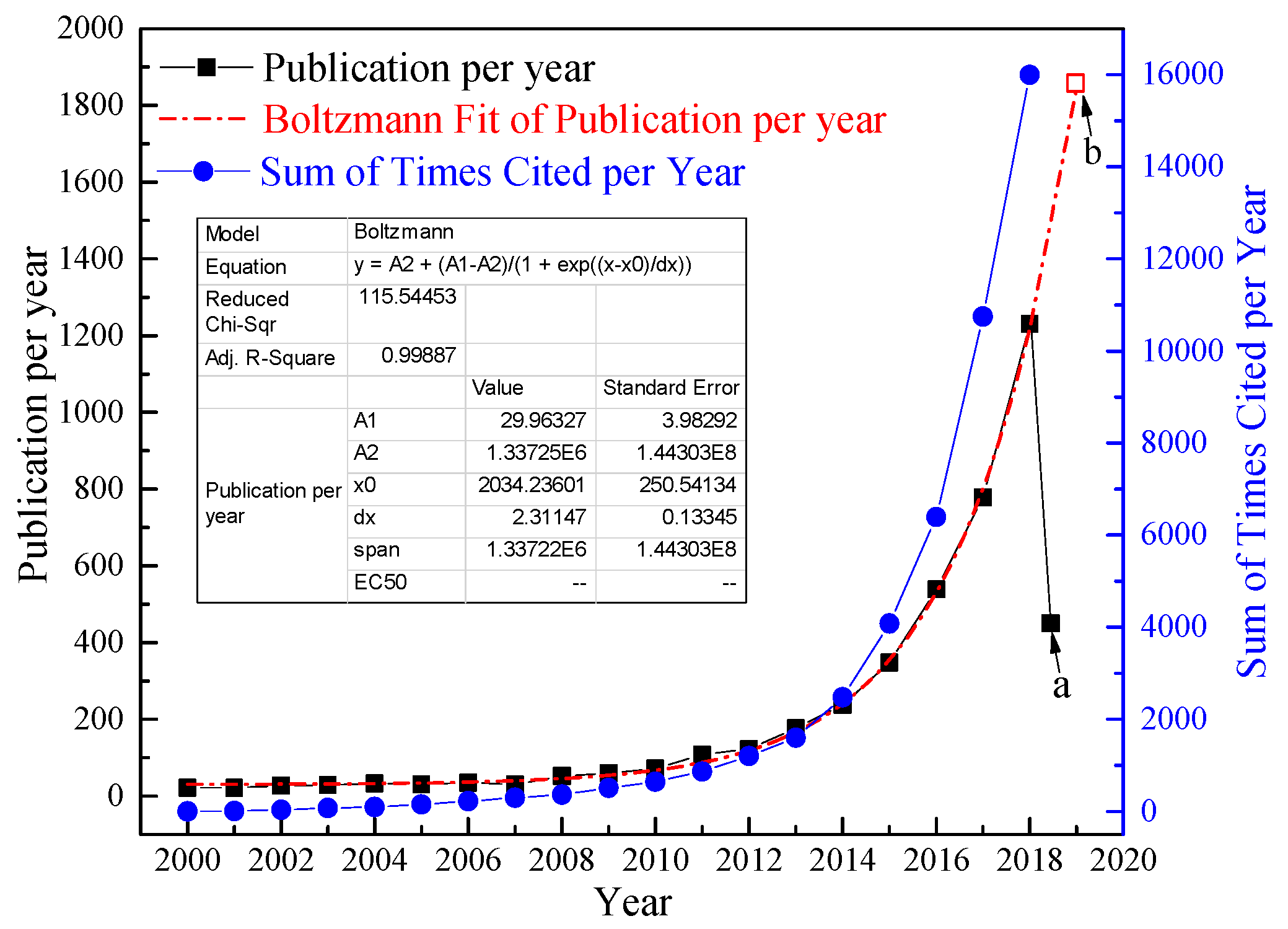
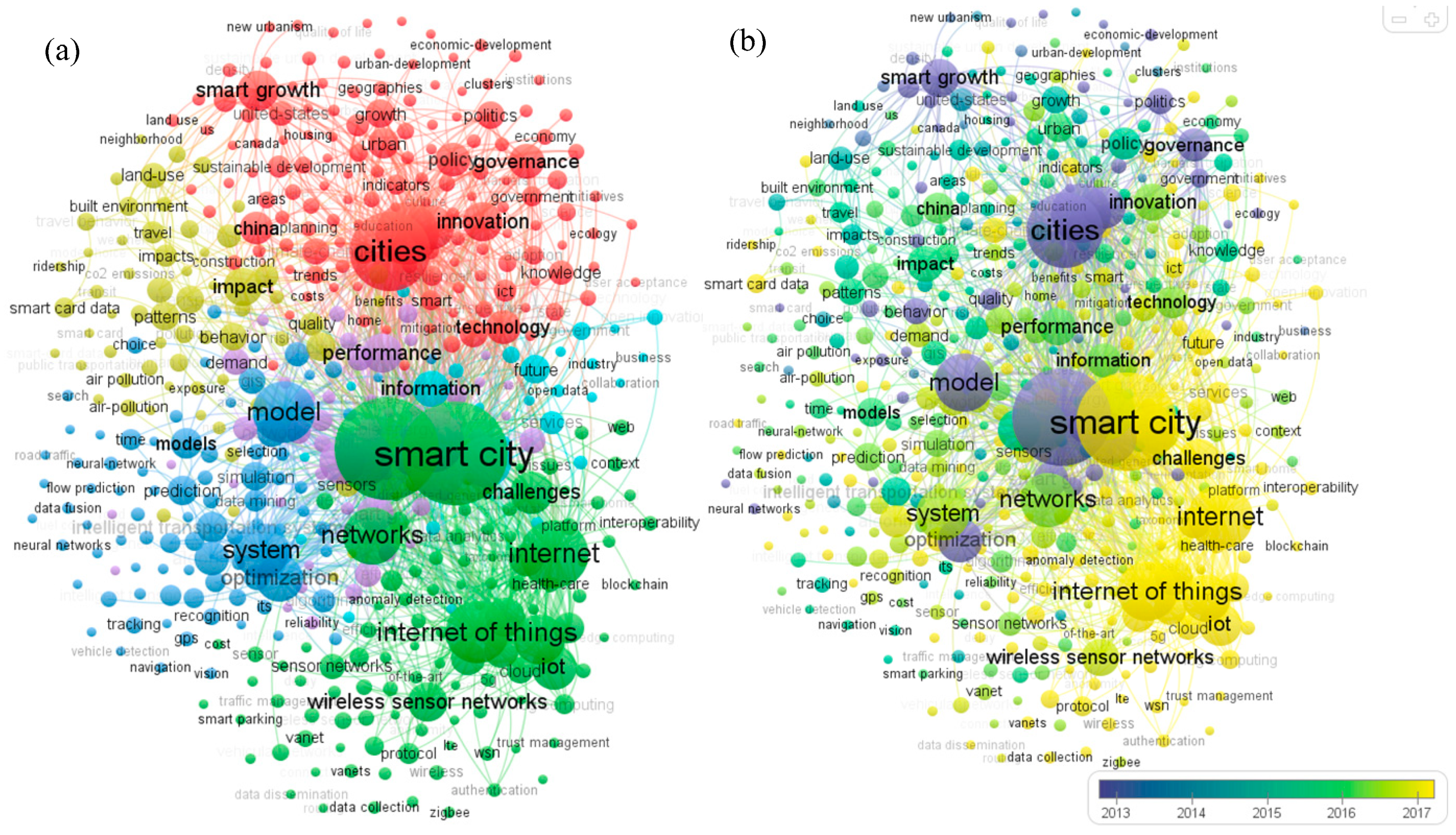
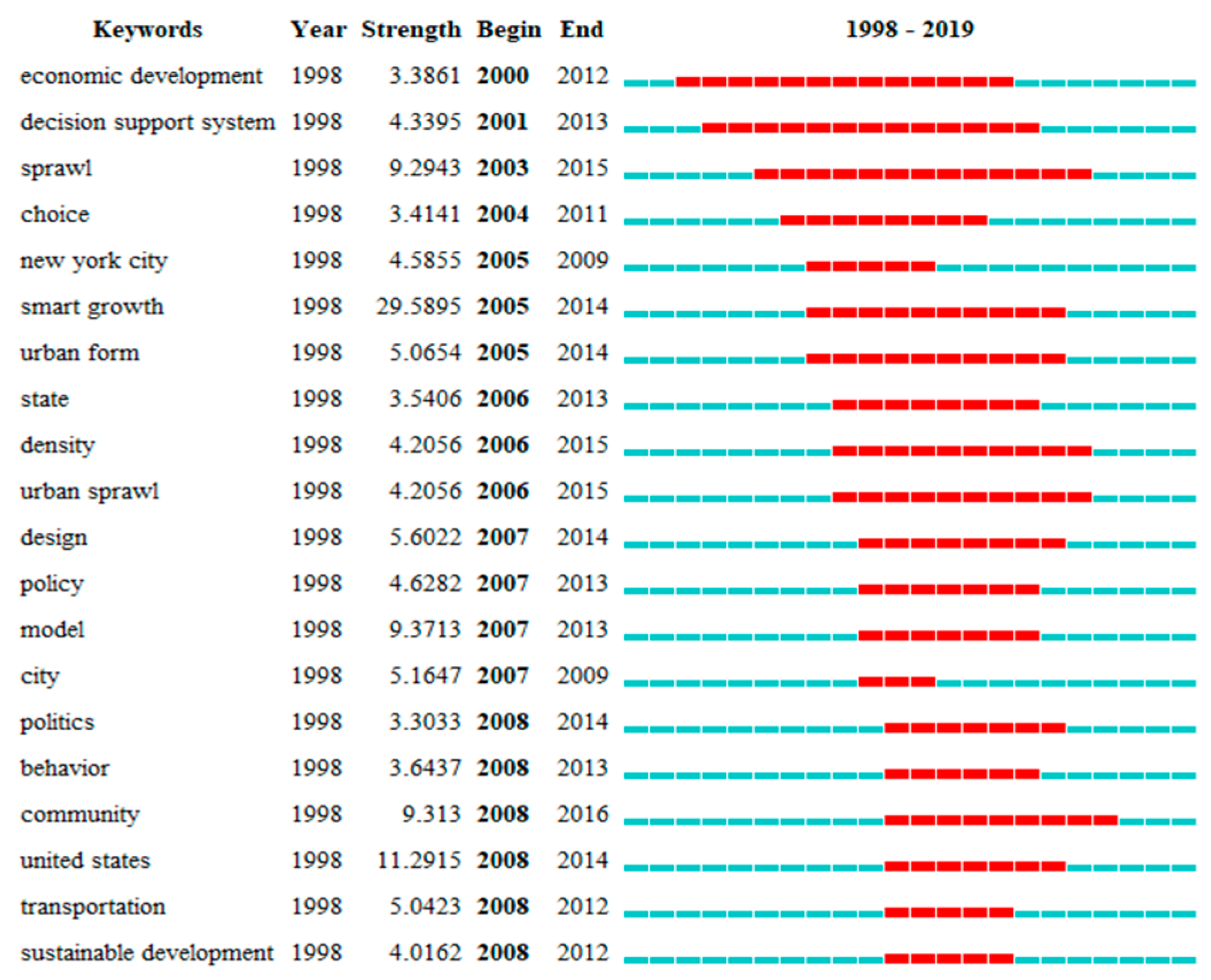

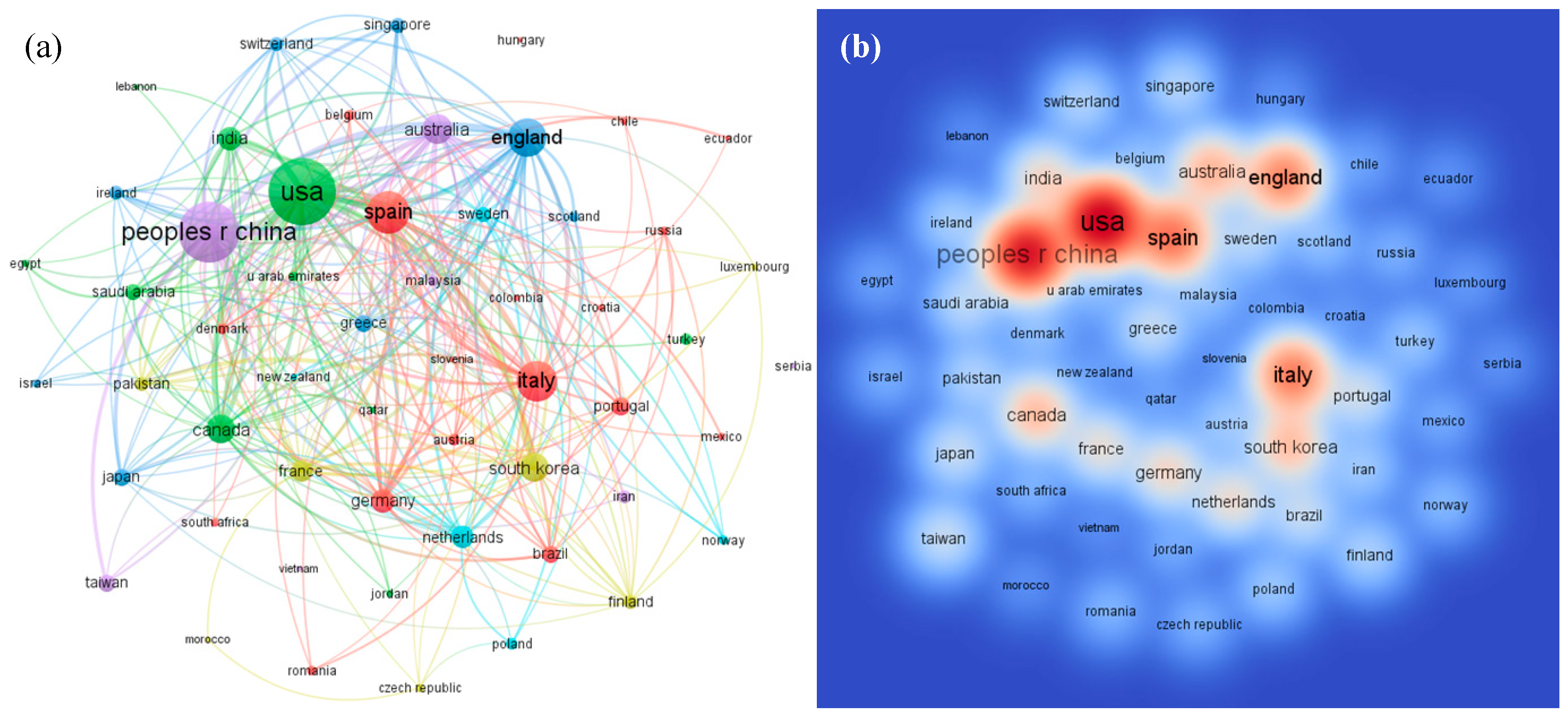
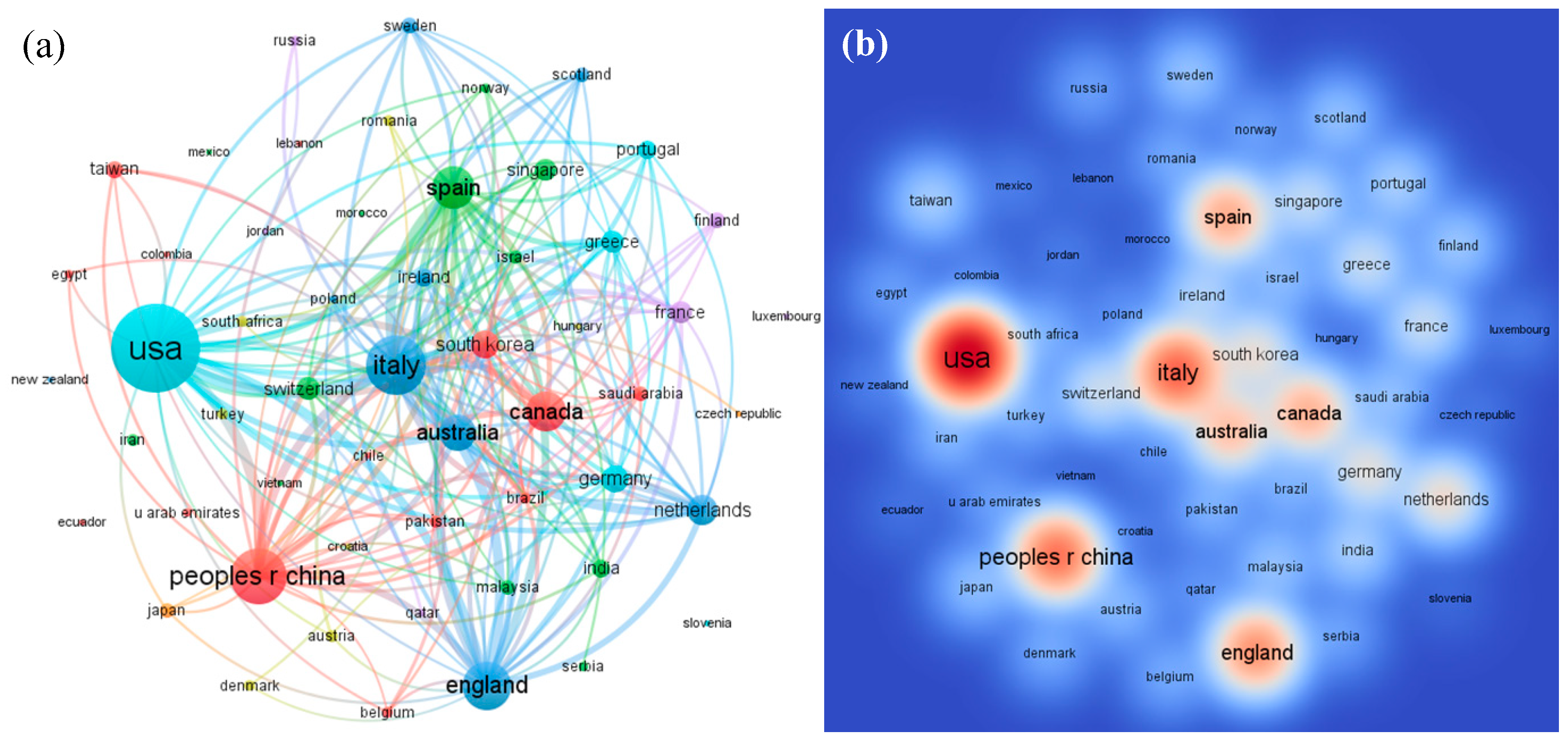
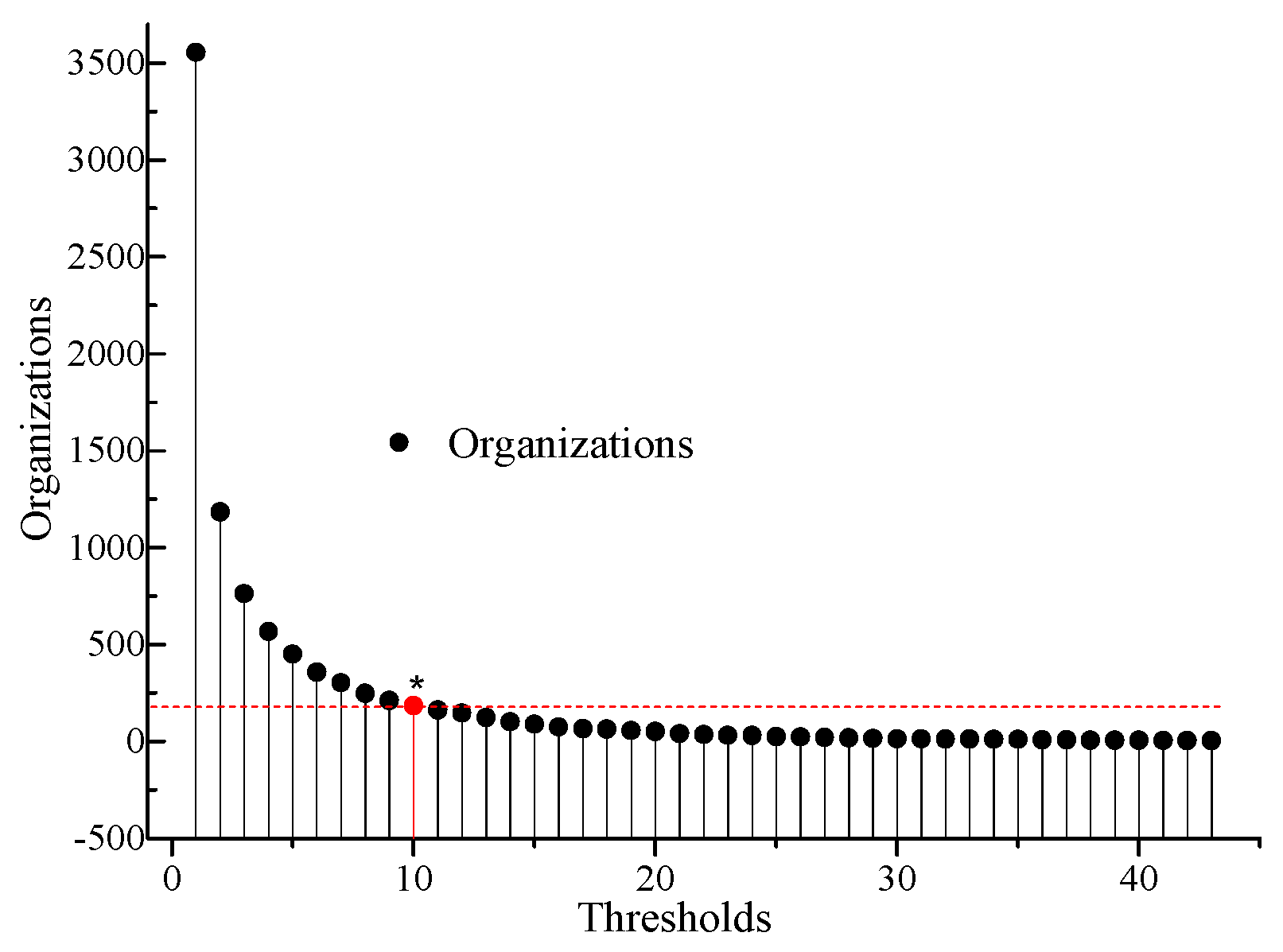

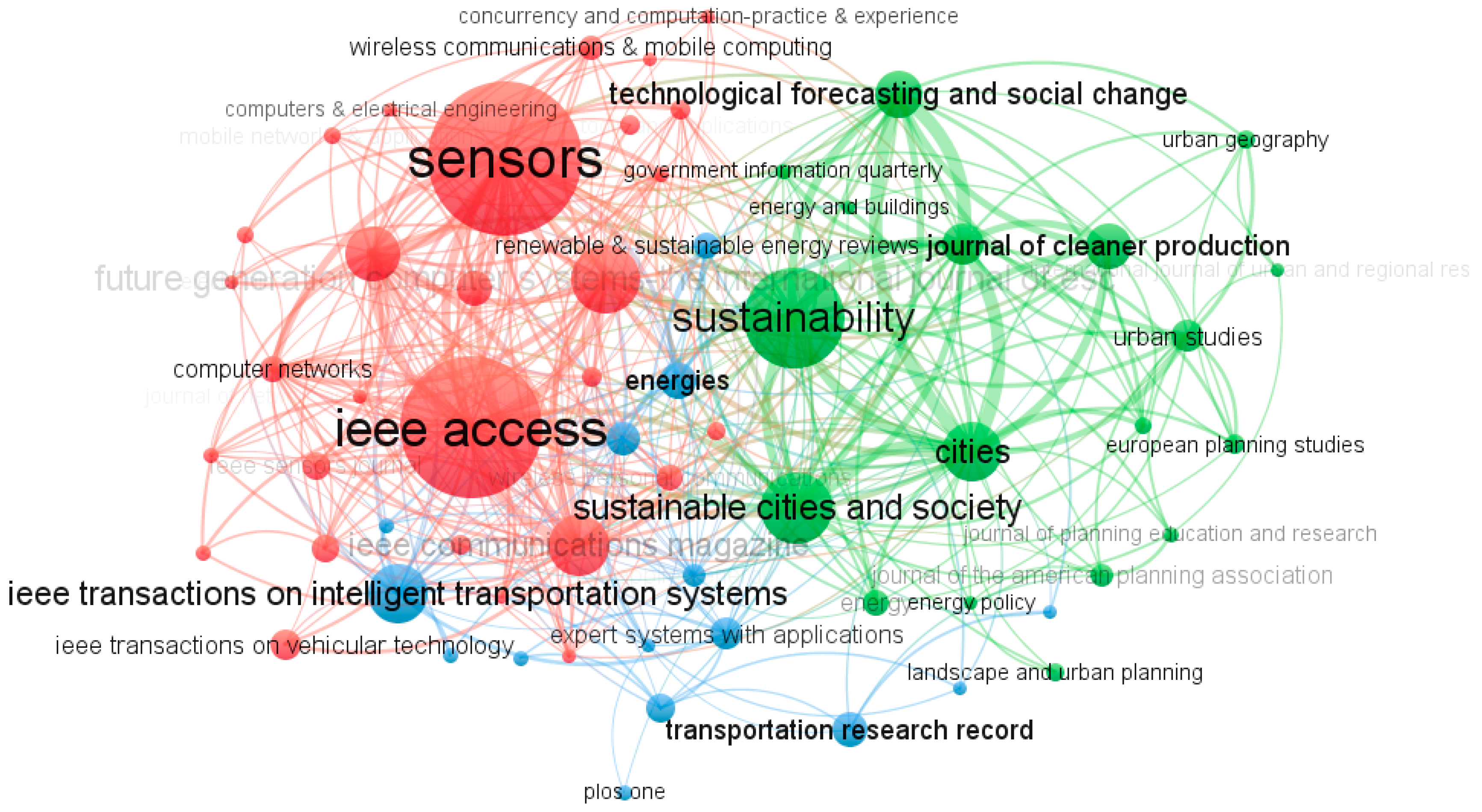
| Ranking | Source Titles | Authors | Organizations-Enhanced | Countries/Regions | ||||
|---|---|---|---|---|---|---|---|---|
| STa | PCb | Name | PC | Organizations | PC | Countries/Regions | PC | |
| Top 1 | Sensors | 215 | Zhang Y | 24 | Chinese Academy of Sciences | 101 | USA | 1053 |
| Top 2 | IEEE Access | 194 | Liu Y | 19 | University of California System | 60 | Peoples R China | 871 |
| Top 3 | Sustainability | 131 | Munoz L | 17 | University of London | 59 | Spain | 454 |
| Top 4 | Sustainable Cities and Society | 88 | Song HB | 15 | State University System of Florida | 53 | Italy | 421 |
| Top 5 | Future Generation Computer Systems | 84 | Wang Y | 15 | Wuhan University | 51 | England | 390 |
| Top 6 | IEEE Communications Magazine | 74 | Li Y | 14 | University of Texas System | 47 | Australia | 249 |
| Top 7 | CITIES | 72 | Yigitcanlar T | 14 | Delft University of Technology | 44 | Canada | 231 |
| Top 8 | IEEE Communications Transactions on Intelligent Transportation Systems | 71 | Kumar N | 13 | Massachusetts Institute of Technology MIT | 45 | South Korea | 222 |
| Top 9 | IEEE Internet of Things Journal | 66 | Li J | 12 | Shanghai Jiao Tong University | 41 | India | 161 |
| Top 10 | Transportation Research Record | 56 | Liu AF/Zhang H c | 12 | University of Bologna | 41 | Germany | 160 |
| RO a | Keywords | Cluster Number b | Links | Total Link Strength | Occurrences | APY c |
|---|---|---|---|---|---|---|
| Top 1 | Smart city | 2 | 378 | 619 | 661 | 2017 |
| Top 2 | Smart cities | 2 | 391 | 619 | 652 | 2011 |
| Top 3 | Cities | 1 | 328 | 388 | 405 | 2011 |
| Top 4 | Internet | 2 | 266 | 296 | 304 | 2017 |
| Top 5 | City | 1 | 292 | 255 | 266 | 2008 |
| Top 6 | IoT | 2 | 237 | 255 | 263 | 2017 |
| Top 7 | Model | 3 | 298 | 242 | 256 | 2008 |
| Top 8 | Management | 4 | 307 | 248 | 255 | 2016 |
| Top 9 | System | 3 | 259 | 198 | 207 | 2016 |
| Top 10 | Things | 2 | 189 | 174 | 174 | 2017 |
| RO a | Authors | Links | Total Link Strength | Documents | AC b | APY c |
|---|---|---|---|---|---|---|
| Top 1 | Song, Houbing | 17 | 25 | 16 | 21 | 2017 |
| Top 2 | Kumar, Neeraj | 6 | 13 | 13 | 7 | 2018 |
| Top 3 | Liu, Anfeng | 8 | 21 | 11 | 15 | 2019 |
| Top 4 | Kantarci, Burak | 6 | 11 | 11 | 13 | 2017 |
| Top 5 | Choo, Kim-Kwang Raymond | 6 | 7 | 11 | 8 | 2017 |
| Top 6 | Sangaiah, Arun Kumar | 5 | 8 | 11 | 4 | 2018 |
| Top 7 | Foschini, Luca | 8 | 24 | 10 | 36 | 2015 |
| Top 8 | Paul, Anand | 7 | 24 | 10 | 18 | 2018 |
| Top 9 | Lloret, Jaime | 6 | 8 | 10 | 6 | 2017 |
| Top 10 | Corradi, Antonio | 5 | 21 | 9 | 37 | 2015 |
| RO a | Countries/Regions | Links | Total Link Strength | Documents | AC b | APY c |
|---|---|---|---|---|---|---|
| Top 1 | USA | 48 | 686 | 1049 | 16,338 | 2010 |
| Top 2 | Peoples Republic of China | 42 | 594 | 870 | 7074 | 2017 |
| Top 3 | Spain | 42 | 262 | 453 | 4346 | 2011 |
| Top 4 | Italy | 44 | 296 | 421 | 7879 | 2016 |
| Top 5 | England | 44 | 413 | 387 | 5546 | 2011 |
| Top 6 | Canada | 43 | 233 | 229 | 4014 | 2006 |
| Top 7 | Australia | 40 | 242 | 248 | 3370 | 2016 |
| Top 8 | South Korea | 32 | 184 | 222 | 2108 | 2007 |
| Top 9 | India | 36 | 134 | 161 | 929 | 2017 |
| Top 10 | Germany | 40 | 178 | 160 | 1983 | 2016 |
© 2019 by the authors. Licensee MDPI, Basel, Switzerland. This article is an open access article distributed under the terms and conditions of the Creative Commons Attribution (CC BY) license (http://creativecommons.org/licenses/by/4.0/).
Share and Cite
Guo, Y.-M.; Huang, Z.-L.; Guo, J.; Li, H.; Guo, X.-R.; Nkeli, M.J. Bibliometric Analysis on Smart Cities Research. Sustainability 2019, 11, 3606. https://doi.org/10.3390/su11133606
Guo Y-M, Huang Z-L, Guo J, Li H, Guo X-R, Nkeli MJ. Bibliometric Analysis on Smart Cities Research. Sustainability. 2019; 11(13):3606. https://doi.org/10.3390/su11133606
Chicago/Turabian StyleGuo, Yi-Ming, Zhen-Ling Huang, Ji Guo, Hua Li, Xing-Rong Guo, and Mpeoane Judith Nkeli. 2019. "Bibliometric Analysis on Smart Cities Research" Sustainability 11, no. 13: 3606. https://doi.org/10.3390/su11133606





